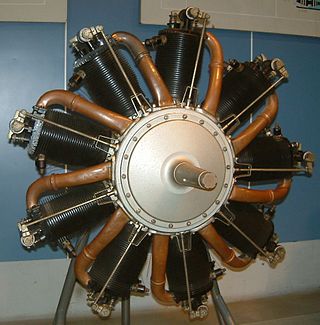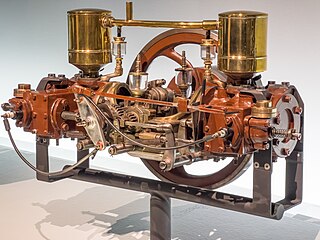The straight engine (also called inline engine) is a configuration of multi-cylinder piston engine where all of the cylinders are arranged in a single row, rather than radially or in two or more cylinder banks.
The straight engine (also called inline engine) is a configuration of multi-cylinder piston engine where all of the cylinders are arranged in a single row, rather than radially or in two or more cylinder banks.
A straight engine is easier to build than an equivalent flat engine or V engine, as it uses one cylinder head rather than two. Inline engines are also narrower than flat engines or V engines; however, they are longer and can be taller.
The engine balance characteristics of a straight engine depend on the number of cylinders and the firing interval.
When a straight engine is mounted at an angle from the vertical it is called a slant engine. [1] Notable slant engines include the 1959-2000 Chrysler Slant-6 engine, 1961-63 Pontiac Trophy 4 engine and the 1968-1981 Triumph Slant-4 engine.
Some buses and diesel multiple unit trains take this concept further by mounting the engines horizontally (i.e. with a slant angle of 90 degrees). This is used to reduce the height of the engine, so that it can be located under the floor of the train or bus.
The straight-three and straight-four configurations are the most common layouts for three- and four-cylinder engines respectively. Straight-five engines are occasionally used, most recently by Audi and Volvo. Straight-six engines were common prior to the 1990s, however most six-cylinder engines now use a V6 layout. Similarly, straight-eight engines were popular in the 1920s to 1940s, however they were replaced by the more compact V8 layout.
This section needs additional citations for verification .(December 2022) |
Many straight engines have been produced for aircraft, particularly from the early years of aviation and through the interwar period leading up to the Second World War. Straight engines were simpler and had low frontal area, reducing drag, and provided better cockpit visibility.
Straight sixes were especially popular in the First World War, and most German and Italian and some British aircraft used descendants of Daimler's pre-war inline six. Prominent examples include the German Mercedes D.III and BMW IIIa, Italian Isotta Fraschini V.4 and British Siddeley Puma.
The British de Havilland Gipsy family of engines and their descendants included straight-four and straight-six upright and inverted air-cooled engines which were used on a wide range of smaller aircraft around the world, including on the Tiger Moth biplane, and helped made the configuration popular for light aircraft. Menasco and Fairchild-Ranger in the United States, Renault in France, Walter in Czechoslovakia, and Hirth in Germany all built a similar range of engines which were popular in their respective markets.
The aviation use of term "inline engine" is used more broadly than for straight engines, since it also applies to other configurations where the cylinders are located in rows (e.g. V engines, W engines, H engines and horizontally opposed engines). [2]
Some straight aircraft engines have used an inverted engine configuration, whereby the crankshaft is at the top of the engine and the pistons hang downwards from it. Advantages of the inverted arrangement include a raised thrust line for improved clearance for the propeller, which either allows for the use of a larger, more efficient propeller, or for shorter undercarriage. Since the thrust line is higher, the engine can be mounted lower in the airframe, improving visibility forward, which is no longer blocked by the cylinder heads. It also allows for a simpler exhaust to keep gasses clear from the cockpit.
In motorcycling, the term "in-line" is sometimes used narrowly, for a straight engine mounted in line with the frame. [3] A two-cylinder straight engine mounted across the frame is sometimes called a parallel twin.[ citation needed ] Other times, motorcycling experts treat the terms parallel, straight, and inline as equivalent, and use them interchangeably. [4] [5]

The rotary engine is an early type of internal combustion engine, usually designed with an odd number of cylinders per row in a radial configuration. The engine's crankshaft remained stationary in operation, while the entire crankcase and its attached cylinders rotated around it as a unit. Its main application was in aviation, although it also saw use in a few early motorcycles and automobiles.

The radial engine is a reciprocating type internal combustion engine configuration in which the cylinders "radiate" outward from a central crankcase like the spokes of a wheel. It resembles a stylized star when viewed from the front, and is called a "star engine" in some other languages.

An aircraft engine, often referred to as an aero engine, is the power component of an aircraft propulsion system. Aircraft using power components are referred to as powered flight. Most aircraft engines are either piston engines or gas turbines, although a few have been rocket powered and in recent years many small UAVs have used electric motors.

A V engine, sometimes called a Vee engine, is a common configuration for internal combustion engines. It consists of two cylinder banks—usually with the same number of cylinders in each bank—connected to a common crankshaft. These cylinder banks are arranged at an angle to each other, so that the banks form a "V" shape when viewed from the front of the engine.
The engine configuration describes the fundamental operating principles by which internal combustion engines are categorized.

A flat engine is a piston engine where the cylinders are located on either side of a central crankshaft. Flat engines are also known as horizontally opposed engines, however this is distinct from the less common opposed-piston engine design, whereby each cylinder has two pistons sharing a central combustion chamber.

A straight-twin engine, also known as an inline-twin, vertical-twin, or parallel-twin, is a two-cylinder piston engine whose cylinders are arranged in a line along a common crankshaft.

A straight-four engine is a four-cylinder piston engine where cylinders are arranged in a line along a common crankshaft.

The inline-six engine is a piston engine with six cylinders arranged in a straight line along the crankshaft. A straight-six engine has perfect primary and secondary engine balance, resulting in fewer vibrations than other designs of six or fewer cylinders.

A straight-three engine is a three-cylinder piston engine where cylinders are arranged in a line along a common crankshaft.

A flat-six engine, also known as a horizontally opposed-six, is a six-cylinder piston engine with three cylinders on each side of a central crankshaft. The most common type of flat-six engine is the boxer-six engine, where each pair of opposed cylinders moves inwards and outwards at the same time. An alternative configuration for flat engines is a 180-degree V engine, where both cylinders move to the right then the left at the same time.

The Jumo 210 was Junkers Motoren's first production inverted V12 gasoline aircraft engine, first produced in the early 1930s. Depending on the version it produced between 610 and 730 PS and can be considered a counterpart of the Rolls-Royce Kestrel in many ways. Although originally intended to be used in almost all pre-war designs, rapid progress in aircraft design quickly relegated it to the small end of the power scale by the late 1930s. Almost all aircraft designs switched to the much larger Daimler-Benz DB 600, so the 210 was produced only for a short time before Junkers responded with a larger engine of their own, the Junkers Jumo 211.

A motorcycle engine is an engine that powers a motorcycle. Motorcycle engines are typically two-stroke or four-stroke internal combustion engines, but other engine types, such as Wankels and electric motors, have been used.
The Focke-Wulf Fw 300 was a proposed very-long-range civil airliner, transport, reconnaissance aircraft and anti-ship aircraft, designed by Focke-Wulf in 1941 and 1942. The design was intended to replace the Focke-Wulf Fw 200 Condor.

The Farman F.430 was a 1930s French light transport designed and built by the Farman Aviation Works. Two variants with different engines were known as the F.431 and F.432.

The Ikarus 451 is a family of research aircraft designs built in Yugoslavia in the 1950s, all sharing the same basic airframe, but differing in powerplants and cockpit arrangements. One member of the family Ikarus 451M became the first domestically-built jet aircraft to fly in Yugoslavia, on 25 October 1952.

In aviation, an inline engine is a reciprocating engine with banks of cylinders, one behind another, rather than rows of cylinders, with each bank having any number of cylinders, although more than six is uncommon. The major reciprocating-engine alternative configuration is the radial engine, where the cylinders are placed in a circular or "star" arrangement.

The Rohrbach Ro VII Robbe was an all-metal, twin engine flying boat built in Germany in the 1920s. It could be adapted to commercial or military rôles.
INLINE ENGINE–A type of reciprocating piston engine in which an even (4-6-8-12) number of cylinders are arranged either in a straight line or in a V-type configuration directly above (or below) the crankcase.
in-line Engine layout in which the cylinders are arranged in a row, and in-line with the wheels of the machine.